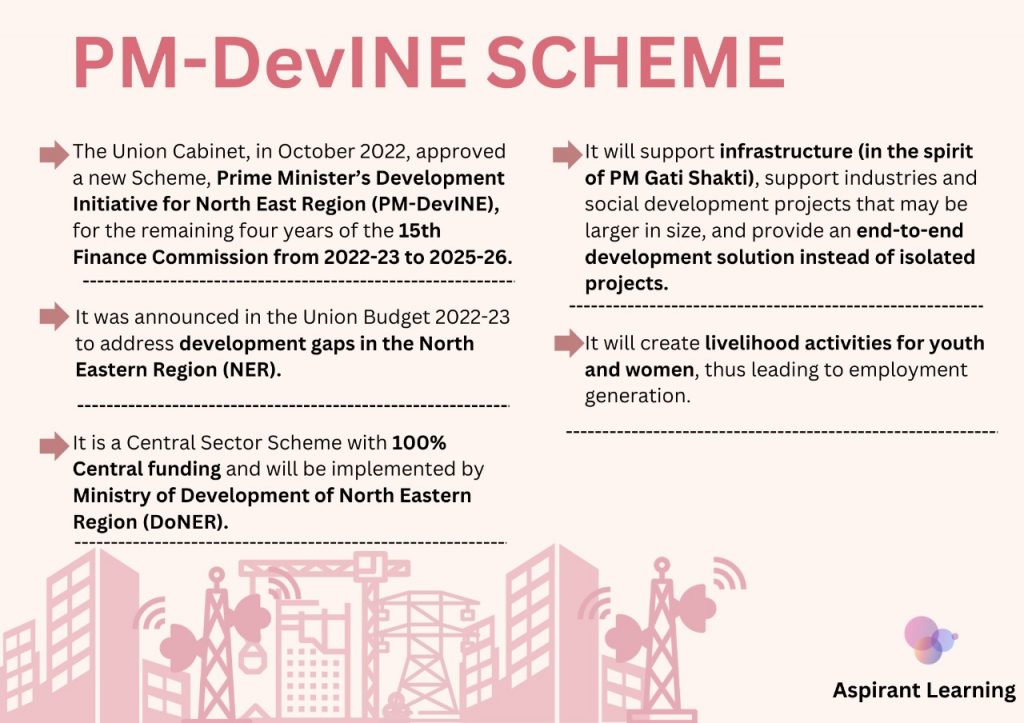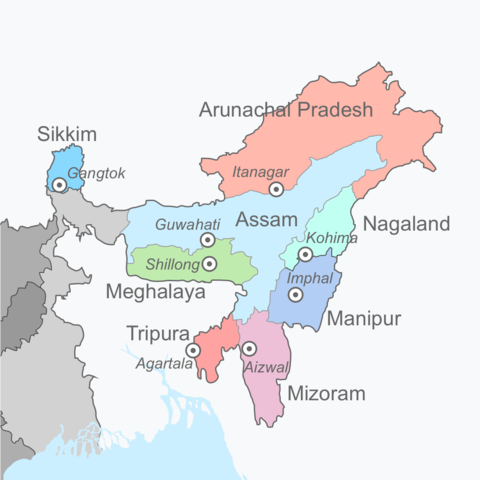News Highlight:
PM Modi attended the Golden Jubilee celebration of the North Eastern Council (NEC) at Shillong and said the Northeast is not the last part of the country but the gateway for trade and ties.
Northeast India:
- About:
- North-East India, fondly called the land of seven sisters, represents both a geographic and political-administrative division of the country.
- The Northeastern Indian States are blessed with a wide range of physiographic and ecoclimatic conditions and are the geographical ‘gateway’ for much of India’s endemic flora and fauna.
- Population:
- North-East is home to 3.8% of the national population and occupies about 8% of India’s total geographical area.
- Geography:
- Siliguri corridor, a narrow strip of land in West Bengal, popularly known as “chicken’s neck” connects this region to the rest of mainland India
- North-East India is the gateway to South-East Asia and beyond. It is India’s land bridge to Myanmar.
Significance of North East for India:
- Strategic Significance:
- Northeast connects India towards South East Asia.
- India’s Act East Policy places the northeastern states on the territorial frontier of India’s eastward engagement.
- Cultural Significance:
- North East India is one of the most culturally diverse areas of the world. It is home to over 200 tribes.
- Popular festivals include the Hornbill Festival of Nagaland, Pang Lhabsol of Sikkim, etc.
- Dowry-free zone.
- The rich tapestry of cultures of the Northeast is reflected in its highly developed Folk dance forms like Bihu (Assam).
- Manipur has a tradition of worshipping nature in sacred groves called UmangLai.
- Economic Significance:
- Economically, the Region is rich in ” TOT ” natural resources (Tea, Oil, and Timber).
- It is a veritable powerhouse with a potential of 50000 MW of hydroelectric power and an abundant reserve of fossil fuels.
- Ecological Significance:
- North East is a part of the otIndo-Burma biodiversity hotspot. It represents one of the highest avian and plants biodiversity of the Indian subcontinent.
- This area has the prestige of having all the bear species in India.

North Eastern Council (NEC):
- About:
- North Eastern Council (NEC) was established by an Act of Parliament in 1971.
- It was formally inaugurated on 7th November 1972 at Shillong and completed 50 years in November 2022.
- This Council is the nodal agency for the economic and social development of the North Eastern Region (NER)
- NER consists of the eight States of Arunachal Pradesh, Assam, Manipur, Meghalaya, Mizoram, Nagaland, Sikkim and Tripura.
- Since its establishment, NEC has been instrumental in setting in motion a new economic endeavour aimed at removing the basic handicaps that stood in the way of normal development of the region.
- Functions:
- To discuss any matter in which some or all of the States represented in the Council have a common interest and advise the Central Government and the Governments of the States concerned as to the action to be taken on any such matter, particularly concerning –
- any matter of common interest in the field of economic and social planning;
- any matter concerning inter-State Transport and Communications;
- any matter relating to Power or Flood-control projects of common interest.
- To formulate and forward proposals for securing the balanced development of the North-Eastern Areas, particularly about –
- a unified and coordinated Regional Plan, which will be in addition to the State Plan, regarding matters of shared importance to that area;
- prioritising the projects and schemes included in the Regional Plan and recommend stages in which the Regional Plan may be implemented; and
- regarding the location of the projects and schemes included in the Regional Plan to the Central.
- To discuss any matter in which some or all of the States represented in the Council have a common interest and advise the Central Government and the Governments of the States concerned as to the action to be taken on any such matter, particularly concerning –

Key highlights of the speech delivered by PM Modi:
- Overcome challenges in the Northeast region:
- Red card to challenges in the Northeast region, including corruption, political nepotism and unrest.
- Northeast is the peace and development gateway for trade and other ties with Southeast Asian countries.
- The government is working on developing border villages, like the Vibrant Border Village project.
- Border areas in Northeast India are not the last miles of the country. Instead, they are India’s main pillars.
- Act fast for northeast’ and ‘Act first for northeast”:
- The Centre has been investing heavily in the northeast with the government’s motto being ‘Act fast for northeast’ and ‘Act first for northeast’.
- The Centre is spending ₹7 lakh crore in the region compared to ₹2 lakh crore after India’s independence.
- Infrastructural development in the Northeast:
- The number of regional airports increased from nine to 16, and the number of flights increased from 900 to 1,900 in the last eight years.
- Work is now underway to connect all the State capitals of the region by railway.
- The PM underscored the 50% increase in the length of national highways in the region since 2014.
- The infrastructure projects in the northeast gained momentum after the launch of the PM-DevINE scheme.
- Digital connectivity:
- The government has been working on improving digital connectivity in the northeast by increasing the optical fibre network, with 6,000 mobile towers set up for ₹5,000 crores.
- The Atma Nirbhar 5G infrastructure will help develop the region’s start-up ecosystem and service sector.
- Security:
- Several peace initiatives in the northeast include peace agreements with extremist groups and resolving decades-old interstate boundary disputes.
- The northeast has moved from violence and conflicts in the last eight years to an era of peace and progress.
- Since 2014, extremism in the region has decreased by 74%, attacks on security forces have come down by 60%, and civilian deaths have decreased by 89%.
Pic Courtesy: Wikimedia commons
content Source: The Hindu



